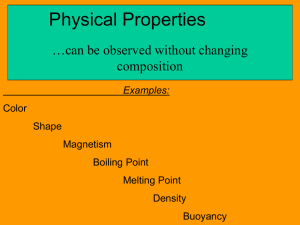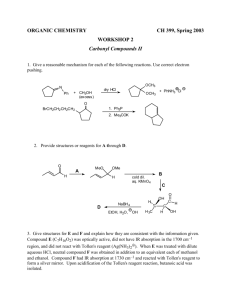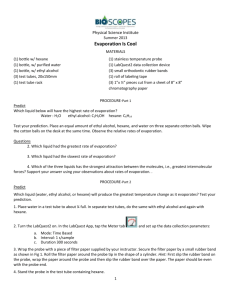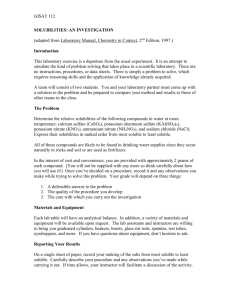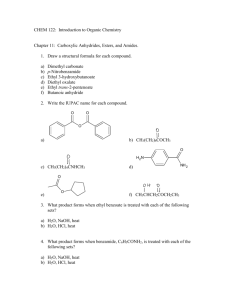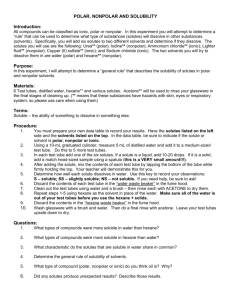Experiment 2 Laboratory Report Sheet
advertisement
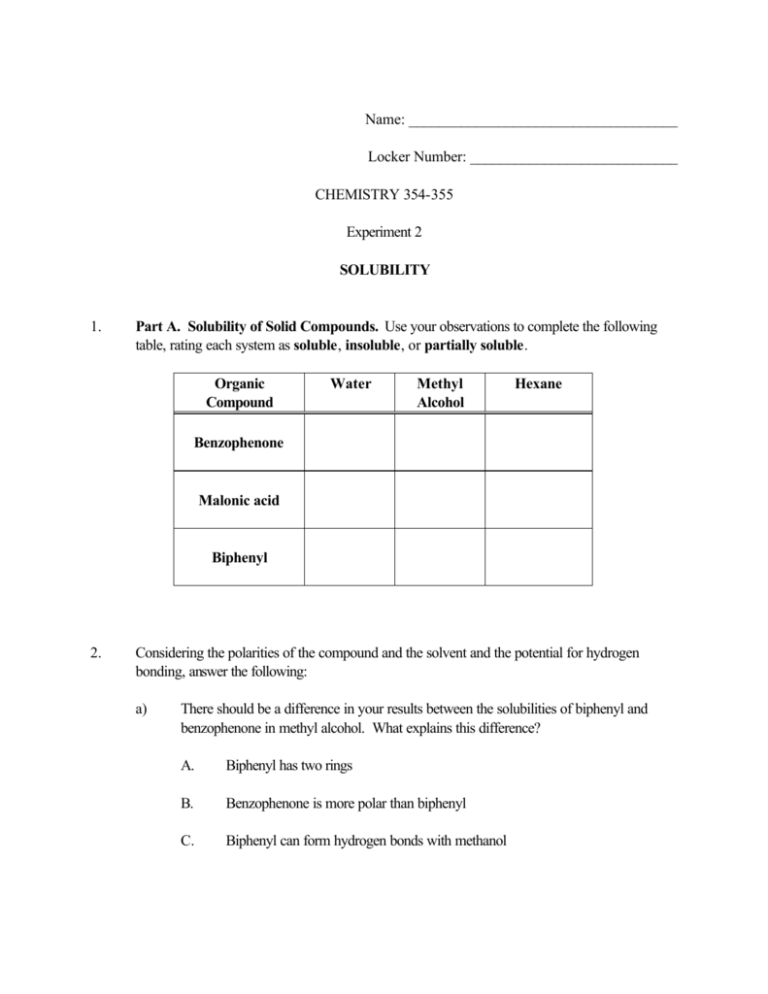
Name: ____________________________________ Locker Number: ____________________________ CHEMISTRY 354-355 Experiment 2 SOLUBILITY 1. Part A. Solubility of Solid Compounds. Use your observations to complete the following table, rating each system as soluble, insoluble, or partially soluble. Organic Compound Water Methyl Alcohol Hexane Benzophenone Malonic acid Biphenyl 2. Considering the polarities of the compound and the solvent and the potential for hydrogen bonding, answer the following: a) There should be a difference in your results between the solubilities of biphenyl and benzophenone in methyl alcohol. What explains this difference? A. Biphenyl has two rings B. Benzophenone is more polar than biphenyl C. Biphenyl can form hydrogen bonds with methanol D. b) 3. They are equally soluble. There should be a difference in your results between the solubilities of benzophenone in methyl alcohol and benzophenone in hexane. Explain this difference. A. Benzophenone has two rings B. Benzophenone has a similar polarity to methanol C. They are equally soluble D. Benzophenone has a similar polarity to hexane. Part B. Solubility of Different Alcohols. Use your observations to complete the following table, rating each system as soluble, insoluble, or partially soluble. Alcohol Water Hexane Methyl alcohol 1-Butanol 1-Octanol 4. What explains the solubility trends that you can deduce from the results for the tests done in each solvent? A. Methyl alcohol is more like water in its structure B. Each alcohol can form hydrogen bonds with water C. As the carbon chain of each alcohol becomes longer, the alcohol becomes more hydrocarbon-like. D. 5. They are all equally soluble in hexane. Part C. Miscible or Immiscible Pairs. Use your observations to complete the following table, rating each pair as miscible or immiscible. System Water and ethyl alcohol Water and diethyl ether Water and ethyl acetate Water and hexane Hexane and ethyl acetate 6. a) Why are water and ethyl alcohol miscible? b) Why are water and hexane immiscible? c) Why are hexane and ethyl acetate miscible? Result 7. Part D. Solubility of Organic Acids and Bases. Use your observations to complete the following table, rating each system as soluble or insoluble. Compound Water 1.0 M NaOH 1.0 M HCl Benzoic Acid Add 6.0M HCl Ethyl 4-aminobenzoate Add 6.0 M NaOH 8. Explain the results for the tube in which 1.0 M NaOH was added to benzoic acid. Write an equation for this. Then describe what happened when 6.0 M HCl was added to this same tube. Write an equation for what happened. 9. Explain the results in which 1.0 M HCl was added to ethyl 4-aminobenzoate. Write an equation for this. Then describe what happened when 6.0 M NaOH was added to this same tube. Write an equation for what happened. ANSWER EACH OF THE FOLLOWING QUESTIONS 1. 2. For each of the following pairs of solutes and solvents, predict whether the solute would be soluble or insoluble. If you do not know the structures of the organic compounds, look them up in The Merck Index or in a similar chemistry handbook. a) Malic acid in water. b) Naphthalene in water. c) Amphetamine in ethyl alcohol. d) Aspirin in water. e) Succinic acid in hexane (NOTE: The polarity of hexane is similar to that of petroleum ether). f) Ibuprofen in diethyl ether. g) 1-Decanol (n-decyl alcohol) in water. Predict whether the following pairs of liquids will be miscible or immiscible. a) Water and methyl alcohol. b) Hexane and benzene. CH3 Thymol OH CH CH3 CH3 c) Methylene chloride and benzene. d) Water and toluene. e) Ethyl alcohol and isopropyl alcohol (2-propanol). 3. Thymol is only very slightly soluble in water, but it is very soluble in 1.0 M NaOH. Explain. 4. Although tetrahydrocannabinol and methyl alcohol are both alcohols, tetrahydrocannabinol is, at best, only very slightly soluble in methyl alcohol at room temperature. Explain. CH3 OH Tetrahydrocannabinol CH3 CH3 O CH2 CH2 CH2 CH2 CH3

